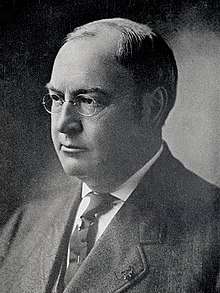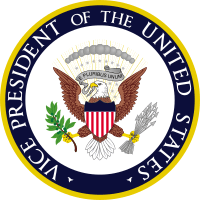James S. Sherman
| James S. Sherman | |
|---|---|
 | |
| 27th Vice President of the United States | |
|
In office March 4, 1909 – October 30, 1912 | |
| President | William Howard Taft |
| Preceded by | Charles W. Fairbanks |
| Succeeded by | Thomas R. Marshall |
| Member of the U.S. House of Representatives from New York's 27th district | |
|
In office March 4, 1903 – March 3, 1909 | |
| Preceded by | Michael E. Driscoll |
| Succeeded by | Charles S. Millington |
| Member of the U.S. House of Representatives from New York's 25th district | |
|
In office March 4, 1893 – March 3, 1903 | |
| Preceded by | James J. Belden |
| Succeeded by | Lucius Littauer |
| Member of the U.S. House of Representatives from New York's 23rd district | |
|
In office March 4, 1887 – March 3, 1891 | |
| Preceded by | John T. Spriggs |
| Succeeded by | Henry Wilbur Bentley |
| Mayor of Utica | |
|
In office March 1884 – March 1885 | |
| Preceded by | John T. Spriggs |
| Succeeded by | Thomas E. Kinney |
| Personal details | |
| Born |
James Schoolcraft Sherman October 24, 1855 Utica, New York U.S. |
| Died |
October 30, 1912 (aged 57) Utica, New York U.S. |
| Resting place | Forest Hill Cemetery |
| Political party | Republican |
| Spouse(s) | |
| Children | 3 |
| Parents |
Richard Updike Sherman Mary Frances Sherman |
| Alma mater | Hamilton College |
| Signature |
|
James Schoolcraft Sherman (October 24, 1855 – October 30, 1912) was an American politician who was a United States Representative from New York from 1887 to 1891 and 1893 to 1909, and the 27th Vice President of the United States from 1909 until his death. He was a member of the interrelated Baldwin, Hoar, and Sherman families, prominent lawyers and politicians of New England and New York.
Although not a high-powered administrator, he made a natural congressional committee chairman, and his genial personality eased the workings of the House, so that he was known as 'Sunny Jim'. He was the first Vice President to fly in a plane (1911),[1] and also the first to throw out the ceremonial first pitch at a baseball game.
Sherman is the most recent Vice President to have died in office.
Youth, education and law career

Sherman was born in Utica, New York, the son of Richard Updike Sherman and Mary Frances Sherman. According to Facts on File,[2] "Sherman was of the ninth generation of descendants from Henry Sherman, a line also connected to Roger Sherman, signer of the Declaration of Independence, and William Tecumseh Sherman, the Union general during the Civil War".
He was educated at Whitestown Seminary, and then at Hamilton College in Clinton New York.[3] At Hamilton, he was noted for his skills in oratory and debate. After his 1878 graduation, he remained at Hamilton for a for a year to study law, then continued his studies at the Utica office of Beardsley, Cookingham and Burdick, which included his brother in law Henry J. Cookingham as a partner. He was admitted to the bar in 1880, and practiced with Cookingham in the firm of Cookingham & Martin. Sherman was also president of the Utica Trust & Deposit Co. and the New Hartford Canning Company. He became mayor of Utica at age twenty-nine.[4]
In 1881, he married Carrie Babcock of East Orange, New Jersey, and they had three sons.
Old-guard conservative in Congress
In 1886, Sherman was elected U.S. Representative from New York's 23rd congressional district as a Republican, and he served 20 years in the House (four years, followed by a two-year break and 16 more years).[5]
At a time when the Republican Party was divided over protective tariffs, Sherman sided with William McKinley and the conservative branch, defending the gold standard against the potentially inflationary 'free silver'.
During his House career, Sherman served as chairman of the Committee on Indian Affairs from the 54th through the 60th Congresses (1895 to 1909).
As Sherman had never held a party leadership post or been a chairman of a major committee such as Ways and Means or Appropriations, he was considered sufficiently neutral to frequently be appointed chairman of the "Committee of the Whole" — a crucial device for speeding up the passage of bills by suspending certain rules at the discretion of the chairman. Henry Cabot Lodge recognized this job as a major test of integrity and judgment, and declared that Sherman was supremely fitted for it.[6] Through Sherman's efforts in 1900, the Sherman Indian High School in Riverside, California was built and named after him.[7]
Vice President
In 1908, Sherman was nominated as the Republican candidate for Vice President on the ticket with William Howard Taft.[8] Although not an obvious front-runner, he balanced Taft's profile, by being both an Easterner and a conservative (it was said that the two wings of the GOP 'flapped together'), and the New York delegates pressed hard for his nomination. The Republicans won by a comfortable margin. At first, Sherman and Taft found themselves at odds over both tariff policy and the role of the Vice President. But Taft presently moved to the right, and the two of them worked together more harmoniously – a relationship eased further by the First Lady's enjoyment of the company of Sherman and his wife. The President declared that Sherman accomplished much on Capitol Hill by his "charm of speech and manner, and his spirit of conciliation and compromise", backed by a "stubborn adherence" to his principles.
Re-nomination, illness and death
From 1910, Taft had experienced several disagreements with ex-President Theodore Roosevelt, who presently walked out and formed his own Bull Moose party. This made re-election for the Republicans almost impossible, but they campaigned on the same ticket in the 1912 contest, with New Yorkers once again supporting Sherman's nomination – the first time that a sitting Vice President had been re-nominated since John C. Calhoun in 1828.
But Sherman's health (he was diagnosed with Bright's disease in 1904) was failing by the time of the 1912 campaign. Less than a week before the election, he died at home in Utica, six days after his 57th birthday, and President Taft was left with no running mate, although Nicholas Murray Butler was designated to receive the electoral votes that Sherman would have received. Taft and Butler came in third place in the election, carrying only eight electoral votes from Utah and Vermont. Democratic candidate Woodrow Wilson and his running mate Thomas R. Marshall won the election while Progressive candidate Theodore Roosevelt and his running mate Hiram Johnson came in second place. The office of Vice-President remained vacant until Marshall's inauguration, on March 4, 1913.
See also
References
- ↑ Brooklyn Daily Eagle, July 12, 1911
- ↑ "Archived copy". Archived from the original on March 5, 2016. Retrieved October 31, 2012.
- ↑ L. Edward Purcell (2010). Vice Presidents: A Biographical Dictionary. Facts on File, Inc. p. 260. ISBN 978-0-8160-7707-6.
- ↑ Arnold, Peri. "James S. Sherman". American President: An Online Reference Resource. University of Virginia. Archived from the original on December 17, 2010. Retrieved December 13, 2010.
- ↑ Congressional Quarterly's Guide to U.S. Elections. Washington, DC: Congressional Quarterly, Inc. 1984. pp. 812, 816, 820, 825. ISBN 0-87187-339-7.
- ↑ https://www.senate.gov/artandhistory/history/resources/pdf/james_sherman.pdf
- ↑ "shermanindianmuseum.org appraisal - turn to gold". shermanindianmuseum.org appraisal. Archived from the original on November 15, 2013.
- ↑ Congressional Quarterly's Guide to U.S. Elections. Washington, DC: Congressional Quarterly, Inc. 1984. p. 73. ISBN 0-87187-339-7.
External links
| Wikimedia Commons has media related to James Sherman. |
- United States Congress. "James S. Sherman (id: S000345)". Biographical Directory of the United States Congress.
- James Schoolcraft Sherman at Find a Grave
- 16th Amendment to the Constitution with Sherman's Signature Image of original document
- 17th Amendment to the Constitution with Sherman's Signature Image of original document
| U.S. House of Representatives | ||
|---|---|---|
| Preceded by John T. Spriggs |
Member of the U.S. House of Representatives from New York's 23rd congressional district 1887–1891 |
Succeeded by Henry Wilbur Bentley |
| Preceded by James J. Belden |
Member of the U.S. House of Representatives from New York's 25th congressional district 1893–1903 |
Succeeded by Lucius Littauer |
| Preceded by Michael E. Driscoll |
Member of the U.S. House of Representatives from New York's 27th congressional district 1903–1909 |
Succeeded by Charles S. Millington |
| Party political offices | ||
| Preceded by Charles W. Fairbanks |
Republican nominee for Vice President of the United States 1908, 1912 (Deceased) |
Succeeded by Nicholas M. Butler |
| Political offices | ||
| Preceded by Charles W. Fairbanks |
Vice President of the United States 1909–1912 |
Succeeded by Thomas R. Marshall |
